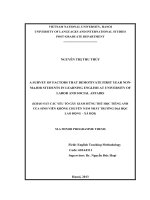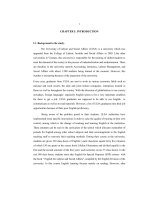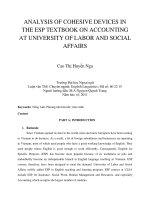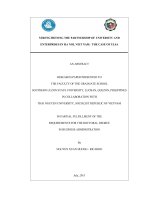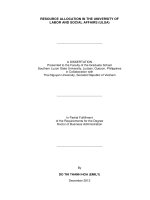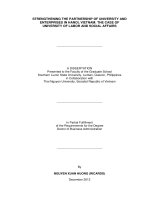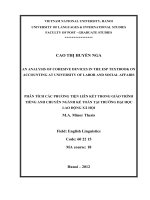ANALYSIS OF COHESIVE DEVICES IN THE ESP TEXTBOOK ON ACCOUNTING AT UNIVERSITY OF LABOR AND SOCIAL AFFAIRS
Bạn đang xem bản rút gọn của tài liệu. Xem và tải ngay bản đầy đủ của tài liệu tại đây (140.67 KB, 6 trang )
ANALYSIS OF COHESIVE DEVICES IN
THE ESP TEXTBOOK ON ACCOUNTING
AT UNIVERSITY OF LABOR AND SOCIAL
AFFAIRS
Cao Thị Huyền Nga
Trường Đại học Ngoại ngữ
Luận văn ThS. Chuyên ngành: English Linguistics; Mã số: 60 22 15
Người hướng dẫn: M.A Nguyen Quynh Trang
Năm bảo vệ: 2011
Keywords: Tiếng Anh; Phương tiện liên kết; Giáo trình
Content
PART A: INTRODUCTION
1. Rationale
Since Vietnam opened its door to the world, more and more foreigners have been coming
to Vietnam to do business. As a result, a lot of foreign subsidiaries and businesses are operating
in Vietnam, most of which need people who have a good working knowledge of English. They
need people whose English is good enough to work efficiently. Consequently, English for
Specific Purposes (ESP) has become more popular because of its usefulness in jobs and
undoubtedly become an indispensable branch in English language teaching in Vietnam. ESP
courses, therefore, have been designed to meet the demand. University of Labor and Social
Affairs swiftly added ESP to English teaching and learning program. ESP courses at ULSA
include ESP for Insurance, Social Work, Human Management and Resources, and especially
Accounting which occupies the largest number of students.
After several years teaching ESP for students of Accounting, I have come to realize that
most of ULSA students lack the adequate linguistic knowledge in English to read and understand
a slightly complex written text, especially texts related to Accounting. So, students tend to make
errors at sentences which lead to misinterpret the correct content of the texts. Moreover, students
are poor in recognizing sentence, word relation and transferring ideas. They find it difficult to
find suitable words to express their ideas, or even their vocabulary is fairly good, they still don’t
know how to connect words to form a complete meaningful sentence. They are, consequently,
not well- organized in their own reading and writing. It’s mostly due to students’ insufficient
language base. They do not pay full attention to the cohesive devices used in the context of the
text.
To understand thoroughly the use of cohesive devices as linguistic means in the text is
very essential for non-major students of English, especially for students of ULSA. The demand
for analyzing cohesive devices used in ESP textbook becomes extremely urgent. Thus I have
decided to study cohesive devices used in the English textbook on Accounting. I do hope that
this study partially helps both teachers and students at ULSA improve the effectiveness of
teaching and leaning ESP
2. Aims of the study
Firstly, the study mainly aims at describing and analyzing cohesive devices in the ESP
textbook on Accounting in terms of grammar and lexis. Secondly, it attempts to find out
teachers’ attitudes towards teaching cohesion. Thirdly, giving out implications to teaching and
learning reading skill in ESP is the last aim of the study.
The following research questions are raised to reach the aims of the study:
1. What are the frequencies of occurrence of cohesive devices in the ESP textbook on
Accounting?
2. What are teachers’ attitudes towards teaching cohesion?
3. Scope of the study
The source of the study takes the current course book at ULSA: “English for Labor and
Social Affairs”, Labor and Social Affair Press, Hanoi 2009. Due to limited time and within
the framework of a minor MA thesis, the study just mainly focuses on grammatical and lexical
cohesion in the ESP textbook for third- year and fourth- year Accounting students at ULSA in
which texts from unit 17 to unit 25 are taken and used as written discourse.
Moreover, the study will not try to propose all the possible solutions to cohesion teaching and
learning but only suggest some implications that are directly drawn from the textbook analysis,
interview and questionnaire analysis.
4. Significance of the study
In term of theoretical significance the study tries to contribute to verifying the correctness
and significance of linguistic theory through discovering the discourse of Accounting. In term of
practical significance, the study gives out some practical applications such as combining
linguistic theory and practice in analyzing written English discourse of Accounting.
5. Methods of the study
Firstly, the methods of description, analysis and statistics in linguistics are used in this
study. The study will base on reviewing materials used in the ESP course for Accounting at
ULSA in order to collect and classify cohesive devices so as to point out the frequency of
occurrence of cohesive devices used in the reading texts.
Secondly, both qualitative and quantitative approaches are used to find out teachers’
attitude towards teaching cohesion and student’s perception of understanding cohesive devices to
do reading exercises. Data from the interview and questionnaire will be analyzed qualitatively
and quantitatively to achieve the objectives of the study.
Thirdly, the findings from data analysis are inductively presented, that is, to move from
less general to more general statements.
6. Design of the study
The thesis consists of three parts:
Part A: Introduction
This part introduces the rationale, aims, scope, significance and methods of the study
Part B: Development
Chapter 1 deals with theoretical background of the research with three main section:
discourse with spoken and written discourse, cohesion with coherence, cohesive devices in terms
of grammar and lexis.
Chapter 2 gives out the methodology used in the study.
Chapter 3 supplies the findings and discussion of analyzing cohesive devices used in
written discourse of textbook on Accounting: grammar cohesion and lexical cohesion to find
each subtype of cohesion’s frequency of use; investigating teacher’s attitudes towards teaching
cohesion and student’s perception of understanding cohesive devices to do reading exercises
Part C: Conclusions
This part consists of a summary of the findings, conclusion remarks, implications and
suggestions for further study
References
1. Brown, G and G.Yule. (1983), Discourse Analysis. Cambridge University Press
2. Carter, D.1(983). Some Propositions about ESP . The ESP Journal 2:131-137.
3. Converse, J. M., & Presser, S. (1986). Survey Questions. Handcrafting the Standardized
Questionnaire. Sage University Paper series on Quantitative Applications in the Social
Sciences, Series No. 07-063. Sage publications, Inc., Beverly Hills.
4. Cook, G. (1989). Discourse. Oxford University Press
5. Crystal, D. (1992). Introduction to Linguistics. London: Pengiun
6. Dornyei, Z. (2003), Questionnaire in Second Language Research Constraction,
Administration and processing, Lawvrence.
7. Dudley-Evans, T.D and St John, J.M. (1998). Developments in English for Specific
Purposes: A multi-disciplinary approach. Cambridge University Press.
8. Dudley-Evans, T.D and St John, J.M. (1991). English for Specific Purposes:
International in Scope, Specific in Purpose. TESOL Quarterly 25:2, 297-314
9. Eggins, S. (1994). An introduction to Systematic Functional Linguistics. London: Printer
10. Halliday, M.A.K (2002). Linguistics Studies of Text and Discourse Continuum. London
and New York
11. Halliday, M.A.K and Hasan, R (19776). Cohesion in English. London: Longman Group
Limited
12. Halliday, M.A.K and Hasan, R. (1985). Spoken and Written Language. Oxford
University Press
13. Halliday, M.A.K and Hasan, R (1989). Language, Context and Text: Aspect of Language
in a Social- Semiotic Perspective. Victoria: Deadkin University Press. London: Longman
Group Limited
14. Hatim, B and Mason, I (1990). Discourse and the Translator. Longman
15. Hoa, N. (2000). An introduction to Discourse Analysis. Ha Noi: VNU Press
16. Hutchinson. T & Waters. A (1987). English for Specific Purposes: A learner-centered
approach. Cambridge: Cambridge University Press.
17. Jordan, P. W. (1998). An introduction to Usability. Taylor & Francis, London.
18. McNamara, Carter, PhD. General Guidelines for Conducting Interviews. Minesota, 1999
19. Malinowski, B. (1923). The Problem of Meaning in Primitive Languages. New York:
Harcourt, Brace and World
20. Nunan, David (1993). Introducing Discourse Analysis. Penguin
21. Oppenheim, A. N. (1992). Questionnaire Design, Interviewing and Attitude
Measurement. Pinter Publishers, London.
22. Quirk, R and Greenbaum, S (1973). A University Grammar of English. London:
Longman Group Limited
23. Richard et al (1998). Longman Dictionary of Applied Linguistics. London: Longman
Group Limited
24. Richards, J and John, P, and Heidi, W (1985).Longman dictionary of applied linguistics.
Harlow, Essex, England: Longman
25. Seliger, H.W and Shohamy, E. (1989). Second Language Research Methods. OUP:
Oxford
26. Telesmans, G (2001- 2002). Discourse Analysis. Hanoi: VNU Press
27. Tickoo, Makham, L. (1998). ESP: State of the Art. SEAMEP Regional Language Centre
28. Widdowson, H.G (1979). Pragmatics. UK: Oxford University Press
